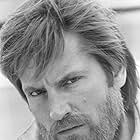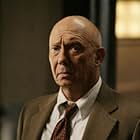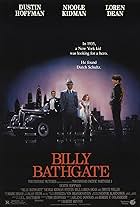IMDb RATING
5.7/10
4.7K
YOUR RATING
Tom Mix and Wyatt Earp team up to solve a murder at the Academy Awards in 1929 Hollywood.Tom Mix and Wyatt Earp team up to solve a murder at the Academy Awards in 1929 Hollywood.Tom Mix and Wyatt Earp team up to solve a murder at the Academy Awards in 1929 Hollywood.
- Nominated for 1 Oscar
- 1 win & 2 nominations total
Castulo Guerra
- Pancho
- (as Cástulo Guerra)
- Director
- Writers
- All cast & crew
- Production, box office & more at IMDbPro
Storyline
Did you know
- TriviaAlthough the plot is mostly fiction, Wyatt Earp and Tom Mix were real-life friends. After Earp retired from law enforcement, he and his wife drifted around, eventually setting in Los Angeles, where he and Mix met. Mix tried to get Hollywood to produce a movie about Earp, but they weren't interested. Earp was hired as a technical consultant for movies starring Mix and William S. Hart. When Earp died in 1929, Mix and Hart were his pallbearers.
- GoofsOne of the movie star doubles at the Candy Store is dressed like Mae West. The film takes place in 1929. West's big screen debut was in Night After Night (1932).
- Quotes
Wyatt Earp: It's all true, give or take a lie or two.
- Crazy creditsThe final frame of the picture freezes, and the following text appears: "And this is how it really happened. Give or take a lie or two."
- SoundtracksBlack And Tan Fantasy
Performed by Duke Ellington and the Duke Ellington Orchestra (as Orchestra)
Courtesy of RCA Records
Featured review
This movie has been kicking around on cable TV lately and I've put off watching it because I expected it to be another very stretched version of a buddy cop movie. The story seems made for it. Experienced old real-life marshal Wyatt Earp teaches callus young phony cowboy Tom Mix how to solve a crime. "Dragnet" on a 1920s back lot. But it wasn't that way at all.
It's true enough that Earp (Garner) hung around Hollywood at the time, or maybe a bit earlier. We don't really get to know much about his past. But although Mix (Willis) drove expensive cars and wore flashy suits and big hats, he wasn't a phony. He'd been a real cowboy too, was a great rider, fought in the Spanish-American war, and could take care of himself. Instead of the expected clash between the master and the tyro, we get two guys who pretty much hit it off with one another right away, and show mutual respect.
It's an interesting friendship.
But then the movie turns darker. A murder takes place. There are fist fights (mostly comic) and several shootouts (done seriously). Willis is kind of cocky. Garner displays the laconic off-hand dignity he showed in "Murphy's Romance," or whatever it was. He's an icon here, with that black outfit and mustache. He's never been a flashy actor, but invariably a competent one. Off-screen he's come up with some dandy spontaneous comments about how the social world of Hollywood and the rest of the country is structured. He's got my vote. Willis isn't bad either.
The rest of the cast does yeoman work but no one has roles that are as interesting as those of the two leads. And the murder story fails to grip the viewer, at least this viewer. I didn't really find myself caring who did it, although it was clear from the beginning who the villains were. There was an exception, though, the British actress playing Garner's former lover. She's simply outstanding in a supporting part, and provides a great example of how to be beautiful without being "beautiful."
I wish the film didn't seem kind of -- I suppose lost is the word. It meanders between comedy, drama, and warmth, without seeming to know just what it wants to do. This isn't a total failure on Edwards' part. It holds together as a story but the characters bounce off one another. Henry Mancini, who wrote many scores for Edwards' films, shows his versatility here.
The score is quiet and unobtrusive (except for one or two brass bands that seem to follow Tom Mix around) and is punctuated by contemporary recordings, including one by Duke Ellington. The photography is first rate. It must be getting hard to find locations that look like Southern California looked in the 1920s before the irruption of humans and their artifacts.
It's worth watching. But I don't know where that title came from. "Sunset." What is the sun setting on? Not Earp. He's old but not doddering, and he can shoot and make love even at the "risk of permanent damage." It's not setting on Hollywood, which would continue to book for another two generations or so. I suppose we'll settle for its being one of those generic titles that could mean anything. "Another Dawn." "Guns of Darkness." "On the Edge." "Sunset." "The Muppets Conquer the Mustang Ranch."
It's true enough that Earp (Garner) hung around Hollywood at the time, or maybe a bit earlier. We don't really get to know much about his past. But although Mix (Willis) drove expensive cars and wore flashy suits and big hats, he wasn't a phony. He'd been a real cowboy too, was a great rider, fought in the Spanish-American war, and could take care of himself. Instead of the expected clash between the master and the tyro, we get two guys who pretty much hit it off with one another right away, and show mutual respect.
It's an interesting friendship.
But then the movie turns darker. A murder takes place. There are fist fights (mostly comic) and several shootouts (done seriously). Willis is kind of cocky. Garner displays the laconic off-hand dignity he showed in "Murphy's Romance," or whatever it was. He's an icon here, with that black outfit and mustache. He's never been a flashy actor, but invariably a competent one. Off-screen he's come up with some dandy spontaneous comments about how the social world of Hollywood and the rest of the country is structured. He's got my vote. Willis isn't bad either.
The rest of the cast does yeoman work but no one has roles that are as interesting as those of the two leads. And the murder story fails to grip the viewer, at least this viewer. I didn't really find myself caring who did it, although it was clear from the beginning who the villains were. There was an exception, though, the British actress playing Garner's former lover. She's simply outstanding in a supporting part, and provides a great example of how to be beautiful without being "beautiful."
I wish the film didn't seem kind of -- I suppose lost is the word. It meanders between comedy, drama, and warmth, without seeming to know just what it wants to do. This isn't a total failure on Edwards' part. It holds together as a story but the characters bounce off one another. Henry Mancini, who wrote many scores for Edwards' films, shows his versatility here.
The score is quiet and unobtrusive (except for one or two brass bands that seem to follow Tom Mix around) and is punctuated by contemporary recordings, including one by Duke Ellington. The photography is first rate. It must be getting hard to find locations that look like Southern California looked in the 1920s before the irruption of humans and their artifacts.
It's worth watching. But I don't know where that title came from. "Sunset." What is the sun setting on? Not Earp. He's old but not doddering, and he can shoot and make love even at the "risk of permanent damage." It's not setting on Hollywood, which would continue to book for another two generations or so. I suppose we'll settle for its being one of those generic titles that could mean anything. "Another Dawn." "Guns of Darkness." "On the Edge." "Sunset." "The Muppets Conquer the Mustang Ranch."
- rmax304823
- May 3, 2003
- Permalink
- How long is Sunset?Powered by Alexa
Details
- Release date
- Countries of origin
- Languages
- Also known as
- Meurtre à Hollywood
- Filming locations
- Production companies
- See more company credits at IMDbPro
Box office
- Budget
- $16,000,000 (estimated)
- Gross US & Canada
- $4,594,452
- Opening weekend US & Canada
- $2,031,678
- May 1, 1988
- Gross worldwide
- $4,594,452
- Runtime1 hour 42 minutes
- Color
- Sound mix
- Aspect ratio
- 2.35 : 1
Contribute to this page
Suggest an edit or add missing content


![Watch Trailer [EN]](https://m.media-amazon.com/images/M/MV5BMzViZGRmYjYtOGIzZS00NGQyLWFlZDktMGQ5ODExYmUwNmU4XkEyXkFqcGdeQXRyYW5zY29kZS13b3JrZmxvdw@@._V1_QL75_UX500_CR0,0,500,281_.jpg)




































